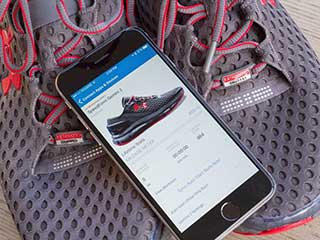Digital Sport
 Smart Running Shoes
Smart Running ShoesModern sport is unthinkable without technology. To grow a champion, physical activity alone is not enough. Not only physicians, psychologists, nutritionists and scientists, but also businessmen, marketing specialists and engineers are involved in the struggle for high results. Technology and science allow athletes to set new records. How much further will science be able to push the limits of sporting achievement?
The famous American runner Jesse Owens in 1936 set a 10.3 seconds world record in the 100 meter race, which endured for nearly 20 years. Jesse was running on the slag-strewn track. Today, the world record belongs to the athlete from Jamaica Usain Bolt, who ran a 100-meter race in Berlin in 2009 in 9.58 seconds. Some researchers claim that the limit for a person is 9.48 seconds. However, it is worth asking the question: how much the next record depends on the person, and how much on technology?
It is possible that Jesse Owens would have run his 100 meters much faster if he, like Bolt, had run along a path covered with a smooth, anti-slip rubber coating. This elastic flooring returns energy to the legs of the running athlete, and does not absorb it like slag. Add to this the new modern ultralight sneakers, and you will understand that the gains in the competition of Owens and Bolt belong to modern scientific developments in the field of training, testing, clothing and equipment.
And here is another example of achieving ultra-high speeds: Formula 1. In this high-tech sport, IT systems with a very complex configuration are needed to achieve the required speeds. Only with proper deployment of IoT (Internet-of-things) devices, is it possible to squeeze the maximum possible out of the car. Cars, or race cars, F1 - powerful as tanks with engines of 600 horsepower and heavy-duty body made of lightweight fiberglass. Everything in this sport is transcendent, and therefore the results of the races depend not only on the pilots of the machines, but also on the engineering team.
The machine is literally packed with special equipment that makes up the complex and versatile IoT system. Up to 200 sensors are involved in test races to collect all the information about the car and its behavior on the track. At the time of racing, the number of sensors is reduced to get rid of excess weight. Sensors and recorders measure everything from physical effort to various components of a car, to engine temperature, tires, pressure levels and aerodynamic information. Information obtained from sensors in real time over wireless channels is compared with baseline readings and a pre-calculated model to determine the state of the vehicle and the pilot.
Add to this the atmosphere of strict secrecy in which teams work. All information from the sensors inside the race cars is strictly confidential, therefore it is encoded and sent in encrypted form. As a result, information exchange between the machine on the highway and the control center is constantly maintained and an enormous amount of information is constantly flowing back and forth, including graphic content.
And here are a couple of examples of high-tech innovations that have begun to be used in big-time sports. Alas, so far they are too expensive for amateur athletes.
Experimental snowboard masks, one of which, worth $58 000, is used, for example, by the British snowboarder Zoe Gillings, is equipped with two cameras. One is aimed at the track, the other - in the eyes of an athlete. The processor assesses where the athlete is looking, what distracts him, and warns in real time of possible collisions and other abnormal situations.
The main gadgets for assessing and monitoring the current status of athletes are the smart watches that Garmin traditionally develops. Various microchips, sensors and recording devices are also sewn into T-shirts, sneakers and other sports gear. For example, HOVR Connected sports shoes are equipped with their own GPS navigation system, and Data Record Sensor® technology tracks, analyzes, and stores almost all of the indicators important to runners.
It turns out that the victory in today's sport is forged not only by the efforts of athletes, but also by engineering and computer support groups. We see the smiling faces of tired winners, but we forget that behind the victory is a team of designers, engineers, and programmers who provided the conditions for high achievements.





